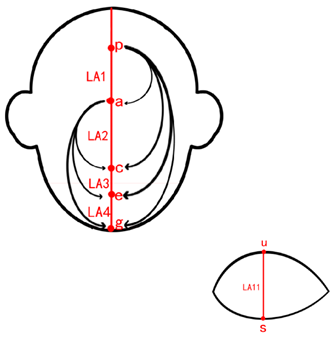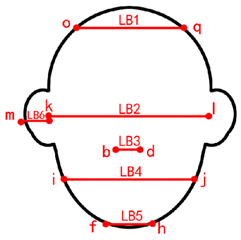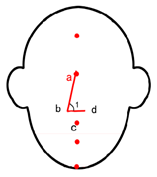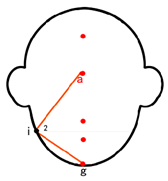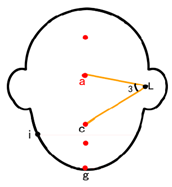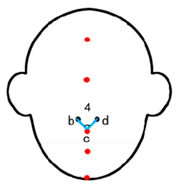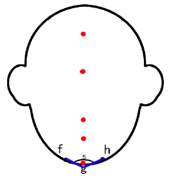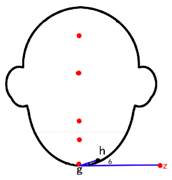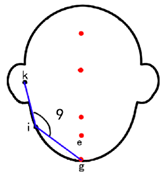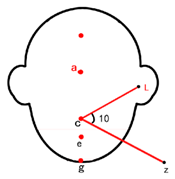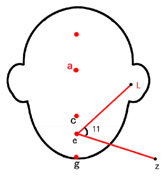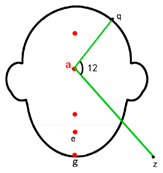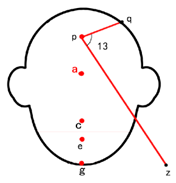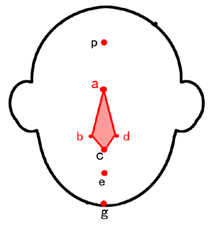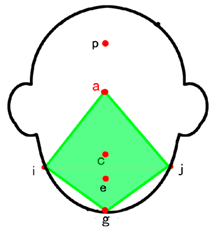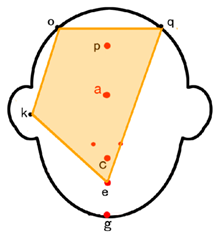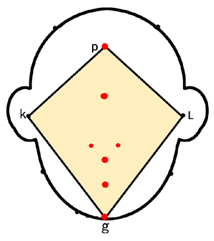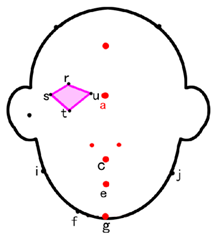Abstract
Many researchers think that the characters in animated cartoons and comics are designed according to the exaggeration or reduction of some features based on the human face. However, the feature distribution of the human face is relatively symmetrical and uniform. Thus, to ensure the characters look exaggerated, but without breaking the principle of symmetry, some questions remain: Which facial features should be exaggerated during the design process? How exaggerated are the faces of cartoon characters compared to real faces? To answer these questions, we selected 100 cartoon characters from American and Japanese animation, collected data from their facial features and the facial features of real people, and then described the features using angles, lengths, and areas. Finally, we compared cartoon characters’ facial features values with real facial features and determined the key parts and degree of facial exaggeration of animated characters. The research results show that American and Japanese cartoon characters both exaggerate the eyes, nose, ears, forehead, and chin. Compared with human faces, taking the eye area as an example, American animation characters are twice as large compared with human faces, whereas Japanese animation characters are 3.4 times larger than human faces. The study results can be used for reference by animation character designers and researchers.
1. Introduction
Many cartoon or animation characters have affected us, leaving a lasting impression. They are the key factor for the success of a cartoon or an animation production. People love characters and interact with them in all aspects of their lives. Fictional characters draw us into their stories in films and television. Like people, animated characters must be good conversational partners [1]. Thus, determining how to design an animated character and make it impressive is an important part of cartoon and animation theory and research.
Perkins [2] introduced two core concepts of comics: exaggeration and personalization, showing that exaggeration is the key factor in creating a cartoon character. Johnston and Thomas [3] mentioned the importance and integrity of exaggeration in Disney’s 12 Rules. Lasseter [4] mentioned exaggeration in three-dimensional (3D) animation. While, Redman [5] stated that exaggeration is based on the enlargement and reduction of real characteristics but not equivalent to distortion, because distortion completely negates the appearance of the prototype. Exaggeration should be accompanied by the recognition of the prototype. Hughes [6] mentioned that in the creation of comic characters, some features of the face should be selected to exaggerate moderately, but not all features should be exaggerated. A greater degree of exaggeration is not necessarily better. The question is: What features of animated character’s faces should be exaggerated and how much exaggeration can still maintain symmetry?
Lu [7] thought that cartoon characters in different countries and regions have different styles but they are usually designed according to the local people’s appearance, and the feature points of cartoon character recognition include hair color, eye size, and chin. Byatt and Rhodes [8] concluded that the characteristics of western comic characters are more obvious and more recognizable than those of Chinese comic characters. Western cartoon characters have more exaggerated facial features.
Goldman and Hagen [9] measured the length and width of the characters’ features in 100 cartoonists’ cartoons. He used quantitative methods to confirm Perkins’s claim that western cartoonists exaggerate the chin and nose. However, cartoonists do not share a common view on the degree of exaggeration.
Research related to face recognition field has provided a variety of facial features and proportion calculation methods. One of the methods is based on some locating points to measure and calculate the facial features of the object through computer face location. Thibaut et al. [10] used 24 reference points to manually determine correspondences in regions, such as eyes, lips, forehead, and chin. As a result, they proposed a system for live puppetry that allows transferring an actor’s facial expressions onto a digital 3D character in real-time. Chen et al. [11] captured exaggeration through a small number of cartoon samples, introduced the intuitive T-rule to describe the relationship between facial features and exaggeration, and used the proportion to describe the relationship between facial features.
Through a large number of animation examples and the theoretical productions of relevant scholars, exaggeration is the core concept of character design [2,3,4,5,6]. So, the questions remain: What features of cartoon characters’ faces should be exaggerated and what is the limit of exaggeration that can still maintain symmetry? If this problem can be explained quantitatively, the cognition and thinking of cartoon character design will be improved in the future.
Computers can accurately recognize facial features by setting feature locating points. Therefore, the area, length, and angle of cartoon character features can be calculated based on locating points [10,11]. In another group of facial studies, Mike [12] combined 2000 pictures of men’s faces in a country to create a face that represents the men’s faces in that country. These two methods helped us to find a method to study the facial features of cartoon characters.
Therefore, in this study, we designed a process for analyzing the facial features of cartoon characters. We first created a composite of eastern and western faces as measurement named “human face”, then we collected area, angle, and length data from facial features of human faces and American and Japanese cartoon characters’ face based on the locating points. Finally, by comparing the calculated results with each other, we determined whether there are design preferences in different areas of a cartoon character’s face and how much the exaggeration degree contributes to excellent cartoon characters.
Cartoons, animations, caricatures, and comics all contain characters that have similar meanings. In this study, “cartoon character” is mainly used to refer to the characters in cartoons, animations, caricatures, and comics.
2. Related Work
2.1. Cartoon Characters Contain Exaggerated Features of Real People
Grammer and Thornhill [13] compared the features of a symmetrical and uniformly distributed face to the faces of ordinary people and considered that the prominence of male facial features is more attractive than a uniform distribution. The more uniform and symmetrical the distribution of women’s characteristics, the more attractive they are. Some researchers believed that the faces with exaggerated features are more recognizable and popular than those with average features [14,15]. Rhodes and Tremewan [16] stated that faces with average feature distribution were more attractive than those with uneven feature distribution. Kris and Gobrich [17] discussed the origin and essence of cartoons based on the exaggeration of the face. Hyde et al. [18] showed that the exaggerated facial morphology of cartoon characters is more suitable for conveying the emotions and intentions of characters. Blair [19] thought that cartoon characters mostly follow the proportion of the three-headed body and five-headed body, and stated that facial features are quite different from real faces. Ameys and Kunzle [20] mentioned that facial features are the starting point for most cartoon character paintings. Belletti and Wade [21] reported that in the process of aesthetic appreciation of women’s faces, the importance of features ranks as follows: Skin > facial structure > hairstyle > eyes > nose > lips > cheekbone. Meagher and Neal [22] selected 40 characters in Disney’s history as samples to measure the features of the face, eyes, and other facial features of the hero and villain characters. Through data comparison and quantification, Meagher proved that Disney’s “good” and “bad” cartoon characters differ from each other in seven characteristic aspects, thereby defining the image of the “hero” and “villain”.
Cartoon theory and practice researchers above introduced opinions on exaggeration. However, how does the exaggeration present in different regions?
2.2. Differences between Eastern and Western Cartoons
Byatt and Rhodes [8] showed that western cartoon characters have more exaggerated facial features and more recognizable than those of Chinese comic characters. Toku [23] concluded that Japanese children prefer closed lines, strong structure, and exaggerated features comics. McCloud [24] thought that Japanese cartoons subjectively accelerate the speed line and blur the effect to show the character’s movement because of cultural differences. Cohn [25] concluded that there are significant differences in characters, space, and perspective between American and Japanese cartoons. Lu [7] mentioned that the characters in Japanese animation are closer to the appearance of European and American people. The purpose of doing so is to cater to western audiences.
In different areas, the cartoon characters have different exaggeration styles and degrees, but few studies have provided a detailed analysis of the forms and degrees that have always existed in the cartoon characters design process.
2.3. Calculation Method of Cartoons Based on Facial Feature Recognition
Some researchers proposed the "Eigen face" and "feature face" recognition technology [26,27]. A series of feature criteria were established to calculate the degree of difference between the object and criterion.
Early face recognition can be used to select some geometric facial features, such as eyes, nose, mouth, and chin, marking the manual positioning points to calculate the shape and relative position Yun-Hong et al. [28] concluded that point characteristics can be widely used in various programs and have been well practiced in implementing some algorithms. Yue-Long et al. [29] mentioned that the number of feature points needed is generally about 60. However, if only the basic structure of the face is described, the number of feature points can be reduced correspondingly.
Computers can calculate the contour and angle of facial features by locating points to achieve the purpose of face recognition [30].
Meethongjan [31] described the whole face pattern and provided 48 different feature points with different weights. Cootes and Taylor [32] performed extraction from image features in a one-dimensional range along the vertical contour. Milborrow and Nicolls [33] performed extraction from two-dimensional images using the square neighborhood of feature points Viola and Jones [34] calculated different features of human faces independently according to location points, and calculated the relationship between different features according to the data of independent features. Cabeza and Kato [35] reported that face structures have an important contribution to face recognition.
Some researchers tried to transform real faces into cartoon portraits. Brennan [36] extracted the contours and feature contours of human faces with a computer and transformed them into lines then he exaggerated or reduced these contours to generate cartoons. Talekar [37] changed the length and angle parameters of facial features to generate cartoons. Liang et al. [38] used partial least squares (PLS) to analyze the correlation between images and cartoons, and captured the artist’s understanding of facial features and exaggerated styles from the cartoon samples. Mra et al. [39] stated that facial portraits suitable for cartoons should be controlled at an exaggerated level of about 20–40%.
In addition, many achievements have been achieved by capturing facial features and expressions and generating real-time 3D facial animation by some algorithms. Hao Li et al. [40] introduce a method for generating facial blend shape rigs from a set of example poses of a CG character that can automatically create optimal blend shapes from a set of example poses of a digital face model. Thibaut Weise et al. [41] combined geometry and texture registration with pre-recorded animation priors in a single optimization and got a system for performance-based character animation that enables any user to control the facial expressions of a digital avatar in real time. Hao Li et al. [42] introduce a real-time and calibration-free facial performance capture framework which developed an adaptive PCA model using shape correctives that adjust on-the-fly to the actor’s expressions through incremental PCA-based learning. Christos et al. [43] presents a solution to retargeting facial animation in a virtual character’s face model based on the kernel projection of latent structure (KPLS) regression between semantically similar facial expressions. Which transferring facial animation to face models’ efficiency. Mousas et al. [44] presents a method to transfer facial blend shapes from a reference to a source face model automatically. Ma and Deng [45] describe a novel real-time end-to-end system for facial expression transformation, without the need of any driving source. Wei and Deng [46] introduces a simple, efficient, yet practical phoneme-based approach to generate realistic speech animation in real time based on live speech input.
3. Materials and Methods
Figure 1 presents the research methods and processes that will be adopted in this study.
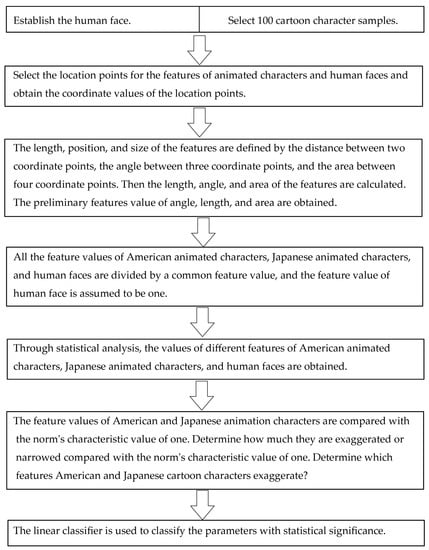
Figure 1.
Experiment flowchart.
3.1. Selection of Research Samples
The animation industry in the United States and Japan is relatively developed, and some famous animations come out every year. The cartoon characters of the two countries have typical characteristics. Therefore, we selected 100 cartoon characters as samples of the excellent animations produced in these two countries, as shown in Figure 2. American animated characters come from films nominated for the Academy Awards or top 10 at the box office or the Rotten tomato website (https://www.rottentomatoes.com) [47] film score of more than 7 points between 2005 and 2017. Japanese cartoon characters were selected from the top 10 films at the box office from 2005 to 2017 and produced by different companies or directors. From each film, regardless of the primary and secondary relationship of the roles, we selected the faces of five characters as the measurement objects. Detail connection of each video is listed in Appendix A.
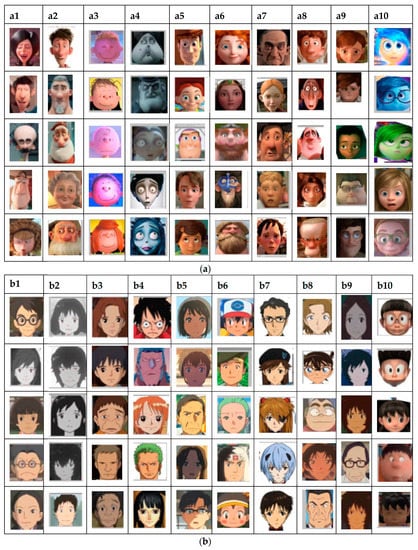
Figure 2.
(a) Samples from American animation; (b) Samples from Japanese animation.
3.2. General Model for Basic Face Reference
Exaggeration must be based on a prototype. Mike [12] synthesized 1000 faces of American men to produce a synthetic face representing all American men and 1000 female faces were synthesized to produce a synthetic American female face. A Japanese male face and a female face were obtained following the same method. In this study, we synthesized the four synthesized faces again, and selected half of the faces to create an absolutely symmetrical human face, as illustrated in Figure 3. After obtaining a human face, we used this template to represent the faces of the two countries and judged how exaggerated the cartoon characters are compared with the human face.
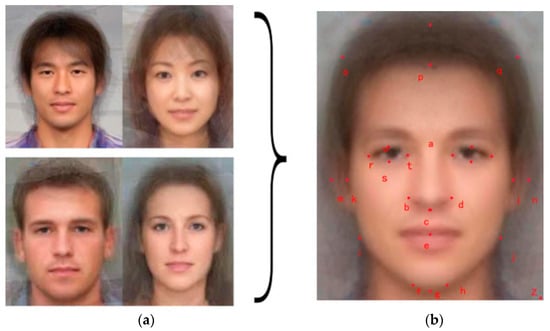
Figure 3.
(a) Face of Japanese and American man and woman synthesized from multiple photographs [12]; (b) A human face synthesized by Japanese and American mass faces and its 26 location points [12].
3.3. Defining Effective Location Points
We marked the location points of 26 positions on the face of the selected character sample. The location points were marked by dots and English letters. For example, the position between the eyebrows center is point “a”. Those location points were used to categorize the features with exaggerated components. In this study, facial features, shapes of different parts of the face, and their proportional relationships were measured. The measurements included the length and width of features, areas of different parts of the face and feature areas, and relationships of angles between features and face shapes. If the length, angle, or area of some features could not be measured for some reason, then we selected one of the values that could be measured as a reference value. For example, the length and area of the ear in some samples were covered by hair so could not be measured accurately, therefore the width of the ear was measured to estimate the size and location.
First, the lengths of the features were divided into two groups: vertical and horizontal. Longitudinally, the lengths of the facial features were observed, whereas in the other group, the width of the face was observed. In the process of measuring the longitudinal distance, the length between p–a–c–e–g was chosen as the basic reference length, = LA1, = LA2, = LA3, and = LA4. LA1 represents the distance between the hairline and eyebrows’ center. LA2 is the distance between the eyebrows center and the nasal floor. LA3 represents the distance from the nasal floor to the lip line. LA4 is the distance between the lip and chin.
The four lengths, LA1, LA2, LA3, and LA4, are distributed on the same axis. Therefore, LA1, LA2, LA3, and LA4 can be listed and combined to obtain six auxiliary reference lengths of LA5, LA6, LA7, LA8, LA9, and LA10. The length between the upper and lower eyebrows, which is not on the axis, was labeled LA11. Thus, in all 11 vertical reference lengths, to measure the width of characters’ features, six transverse distance measurements were selected: = the width of the forehead, named LB1, = the width of the face, named LB2, = the width of the nose, named LB3, = the width of mandibular, named LB4, and = the width of the chin, named LB5. Detail definition of face features are listed in Table 1.
3.4. Methods and Tools for Collecting Location Point Data
Using the measuring tool function of Photoshop CS6 (Adobe System Incorporated, San Jose, CA, America), we could collect coordinate data of a pixel in each picture. Therefore, we created a square of 10 × 10 cm, and enlarged all the character face samples to ensure the whole head of the characters fit into the square (the top of the head to the chin matched the top and bottom of the square picture and the left and right sides of the ears connected the left and right edges of the square, respectively). The coordinate data of each location point were collected using a measuring tool in Photoshop CS6 (Adobe System Incorporated, San Jose, CA, America) from the location pixel. For example, for a character, point “a” at the eyebrows center, the coordinates are X 697, Y 549. For point “e” at the lip tip, the coordinates are X 698, Y 358. The coordinates of these X and Y can accurately represent the location of a certain point. After obtaining these coordinate data, the data were input to Excel (Microsoft Corporation, Redmond, WA, America), and the lengths, angles, areas between the location points, and the location points were calculated through the program to obtain the initial data:
- (1)
- The length or width of the distance between two points: for example, the length value of a–c of a character is 356, a–c represents the length of this character’s nose.
- (2)
- The angle constructed by three points: for example, for a character, its angle “a–i–g” is 98. The three “a–i–g” points construct the angle from the eyebrows’ center point, to the point of the left jaw, and to the point of the chin.
- (3)
- The value of the area constructed by four points. For example, the area value of “r–s–t–u” of a character sample is 8176. r–s–t–u represents the area of the eye.
After preliminary calculation of the facial length, angle, and the area of the 100 characters from the two countries was completed, we collected and calculated the initial data of the length, angle, and area of the features of the human face.
3.5. Seeking a Common Length from All Features as a Measurement of Normalization
According to the preliminary data, the characteristics of the 100 cartoon characters demonstrated similarities in some characteristics, and large differences in others. At the beginning of data collection, these cartoon characters were placed in a square to give all samples a uniform specification and standard. However, in order to comparatively analyze the exaggeration of all characters, it was necessary to find a common characteristic value from these cartoon facial features as a measurement.
To find the facial feature with the minimal change in length, we used Excel’s ranking function (Microsoft Corporation, Redmond, WA, America) to rank the data from the research samples. The ranking steps were as follows. Sixteen features (from LA1 to LA11 and from LB1 to LB5) were ranked by length, and then renamed based on the rank. Hundred faces were measured, and the standard deviations of the ranks of each facial feature were calculated. The facial feature with the minimal deviation was served as the unit of length of the face. Other facial features were divided by the unit of length, and therefore, the lengths of all faces can be compared by the same criteria. For example, the L3 of character A received five points, the L3 of character B received four points, and the L3 of character C was assigned five points. By analogy, we obtained the average length of feature L3 of the 100 characters and finally, calculated the standard deviation of the shortest value and the longest value of the features.
By sorting, the feature parameters with the largest and lowest standard deviations were found. We preliminarily inferred that the feature values with the smallest length standard deviation were the feature values of all characters (without too much design). During cartoon character design, those features with large standard deviation in terms of length are the focus of the design.
After ranking, we changed the length code of L1 to L16 back to LA1 to LB5. Through the ranking result, we found that the minimum value of L15 (LA7) was 13, and the maximum value was 16. Compared to other feature’s lengths, L15 (LA7) was the most constant feature length of the 16 lengths. Therefore, the average parameter of L15 (LA7) was used as a reference standard for all character features for normal alignment. After the average parameter L15 (LA7) was obtained, the original length and area data were divided by the value of L15 (LA7), and the length and area values of all character samples for comparison were obtained.
Following the same process, the average values of length, area, and angles of the human face were obtained by dividing the original data for human face length and area by the parameter value of L15 (LA7). The average value of the face norm was assumed to be one to measure the degree of exaggeration of animation characters.
3.6. Statistical Methods Description
After dividing the average parameters by LA7, A1 to A13, LA1 to LB5, and R1 to R6 of Japanese and American cartoon characters were tested by independent sample T. The average value and standard deviation were counted to find the differences between Japanese and American characters in 13 angles, 16 lengths, and six areas.
Secondly, the characteristics data of the human face were obtained by a single sample T-test. Then, the face human face data were compared with the length, area, and angle data of the faces of the American and Japanese animated characters. The ratios of the human face to American and Japanese animation facial features were obtained.
3.7. Classification Performance Evaluation
Face parameters are used to distinguish between Japan and the USA by a linear classifier. Define
- M1 = Max (parameters Japan and USA);
- M2 = Min (parameters Japan and USA);
- d = (M1 − M2)/20;
A cutoff point T is chosen from and M1 to M2 with increment d. Each carton image was classified as Japan when the parameters xi < T, otherwise classified as the USA. Then there are four basic combinations of actual data category and assigned category:
- (1)
- True positive, TP (Japan video and classified as Japan video),
- (2)
- True negative, TN (USA video and classified as USA video),
- (3)
- False positive, FP (USA video and classified as Japan video),
- (4)
- False negative, FN (Japan video and classified as Japan video).
The following three classification performance criteria are used:
- Sensitivity = TP/(TP + FN);
- Specificity = TN/(TN + FP);
- Accuracy = (TP + TN)/(TP + TN + FP + FN).
Then, the maximum accuracy of the same parameter is collected, with corresponding sensitivity and specificity pairs.
4. Results
The study results are presented in three sections: The comparison of the 13 angles, the comparison of the 16 lengths, and the comparison of the six areas. Each comparison includes the comparison between the human face and the American cartoon characters and the comparison between the human face and Japanese cartoon characters. By comparing the data, we determined how much the certain cartoon character’s feature values are exaggerated compared with the value of one assigned to the human face. The feature values that achieve significant differences are identified here by the feature code.
4.1. Face Angles Comparison
Table 2 shows that the cartoon characters are significantly different from the human face at A1, the length and shape of the nose at A2, A9, the shape of the face below the eyebrows at A3, the length of the middle part of the face at A5, A6, the width and sharpness of the jaw at A7, A8, the distance between the left and right mandible at A7, A10, the jaw at A11, the length of the face contour at A12, and A13 the length and position of head contour.

Table 2.
Comparison of angles of a human face with Japanese and American cartoon characters faces. Data are represented as mean (std). a is p-value of t-testing between human and Japanese Animation. b is p-value of t-testing between human and American animation. * p-value < 0.05; ** p-value < 0.01; *** p-value < 0.001.
There were nine significant differences in the angles between human faces and Japanese cartoon characters: A1, A2, A7, A8, A9, A10, A11, A12, and A13. There were six significant differences in the angles between the human face and American cartoon characters: A3, A5, A6, A9, A11, and A12.
We assumed that the value of the human face is 1. The average value of A1, A2, A7, A8, A9, A10, A11, A12, and A13 show that Japanese anime characters were exaggerated by 9° compared with human face in the angle from the eyebrows center to left alar of nose to base of nose, the angle from eyebrows center to left jaw to chin was reduced by 8°, the sharp angle of the chin was exaggerated by 4.6°, the jaw was 5° lower, there was a 5.2° reduction in the ears and the face was shorter, the nose position was 3.2° higher, the mouth position was 3.8° higher, the forehead and upper eyebrows’ center positions were 3° higher, and hairline was 5.4° lower.
The average values of A3, A5, A6, A9, A11, and A12 show that the American cartoon characters have longer noses, higher brows, and lower mouths than human face; the distances were 6.5° exaggerated in the distances between these features. The width of the jaw was 8.2°, 2.5° lower chin, 4.1° exaggerated distance between upper ears and lower mouth. and 3.5° shorter distance between the forehead and the lower eyebrows’ center position. There were seven significant differences in angle values between Japanese and American cartoon characters: A1, A3, A8, A10, A11, A12, and A13. American animation characters are larger than Japanese animation characters in angles of A3, A8, A10, A11, and A12 smaller than Japanese animation characters in the angles of A1 (nose length) and A13 (profile of side head).
4.2. Study Results of Length
Table 3 shows that the cartoon characters are significantly different from the human face in LA2, length of the nose, LA8, length from the eyebrows’ center to the lip line, LB6, the width of the ears, and LA11, the length between the upper and lower eyelids.

Table 3.
Comparison of lengths of a human face with Japanese and American cartoon character faces. Data are represented as mean (std). a is p-value of t-testing between human and Japanese Animation. b is p-value of t-testing between human and American Animation. * p-value < 0.05; ** p-value < 0.01; *** p-value < 0.001.
There were twelve significant differences in the length between the human face and Japanese animation characters: LA2, LA8, LB3, LA3, LA10, LB2, LB6, LB1, LA5, LA6, LA11, and LA4. There were ten significant differences in the lengths between the human face and American animation: LA2, LA8, LA9, LB5, LB4, LB6, LA1, LA11, LB1, and LB2.
The average values of LA2, LA8, LB3, LA3, LA10, LB2, LB6, LB1, LA5, LA6, LA11, and LA4 show that Japanese anime characters were 1.1 times exaggerated compared to human faces for the length of the nose, 1.1 times exaggerated for the length of the eyebrows’ center to the lip line, 1.6 times lower for the width of nose, 1.2 times exaggerated in the distance from the nose to the lip line, the length from the nose base to the chin exaggerated 1.1 times, 1.1 times exaggerated in the width of the face, 1.9 times exaggerated in the width of the ear, 1.1 times exaggerated in the width of the skull, 1.1 times exaggerated in the distance from the hairline to the base of the nose, exaggerated one time in the distance from the hairline to the lip line, 2.7 times exaggerated the distance between the upper eyelid and the lower eyelid, and 1.6 times lower in the distance between the lip line and the chin.
The average values of LA2, LA8, LA9, LB5, LB4, LB6, LA1, LA11, LB1, and LB2 show that American cartoon characters were 1.2 times exaggerated in the length of nose, 1.2 times exaggerated in the length from the eyebrows’ center to the lip line, 1.1 times exaggerated in the distance between the eyebrows’ center to the chin, 1.4 times exaggerated in the distance from the nasal floor to the lip line, 1.1 times exaggerated in the width of the mandible angle, 1.4 times exaggerated in the width of their ears, 1.4 times reduced in the length of the foreheads, 2.2 times exaggerated in the length of the eyes, 1.1 times exaggerated in the width of the skull, and 1.1 times exaggerated in the width of the face.
Compared with the length and width of the features of American and Japanese cartoon characters, there were eleven significant differences: LA2, LA8, LA9, LB3, LA10, LB5, LA4, LB1, LA1, LA5 and LA6.
American animation characters are longer than Japanese animation characters in the length of LA2 nose, LA8 eyebrows center to the lip line, LA9 eyebrows’ center to the chin, LB3 width of the nose, LA10 the nasal floor to the chin, LB5 the width of the chin, and LA4 lip line to cthe hin. American characters are shorter than Japanese animation characters in the length of LB1 width of the skull, LA1 eyebrows center to the hairline, LA5 hair line to the base of nose, and LA6 hair line to the lip line.
4.3. Study Results of Area
Table 4 showed that there were four significant differences in the feature areas between the human face and Japanese cartoon characters: R1, R4, R5, and R6. There were four significant differences in the feature areas between the human face and American animation: R1, R2, R3, and R6.

Table 4.
Comparison of areas of a human face with Japanese and American cartoon characters’ faces. Data are represented as mean (std). a is p-value of t-testing between human and Japanese Animation. b is p-value of t-testing between human and American Animation. * p-value < 0.05; ** p-value < 0.01; *** p-value < 0.001.
The average values of R1, R4, R5, and R6 show that Japanese anime characters has smaller sized of noses by 1.5 times compared with the human face, 1.25 times larger area between the left upper point of the skull to the left cheekbone to the lip bead to the right upper point of the skull, 1.1 times larger area between eyebrows center, the left and right cheekbones, and the chin, and 3.4 times larger eyes.
The average value of R1, R2, R3, and R6 show that American cartoon characters have 1.3 times larger noses, 1.3 times larger area between the eyebrows’ center, the left and right mandible angles, and the chin, 1.25 times larger area between the left and right mandible angles and the chin, and two times larger eyes.
There were five significant differences between American and Japanese cartoon characters in the areas: R1, R2, R3, R4, and R6
American animation characters are larger than Japanese animation characters in the area of R1, the nose. R2, between the eyebrows center, the left and right mandible angles and the chin, and R3, between the left and right mandible angles and the chin, and smaller than Japanese animation characters in the area of R4, from the left upper point of the skull to the left cheekbone to the lip bead to the right upper point of the skull and R6, the eyes.
4.4. Classification Performance Evaluation
Maximum accuracy of selected face parameters is listed in Figure 4. The results of numerical comparison of all the features show that the values of LB3 and R1 are the highest. AUC of LB3 is 0.82, AUC of R1 is 0.78, both are nose-related parameters.
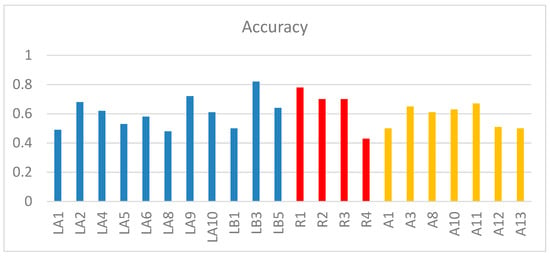
Figure 4.
Classification accuracy of selected face parameters.
5. Discussion
Among the 16 proposed features, eyes, nose, ears, and the position of the mouth are the focus of the character’s face design, regardless of the eastern or western animation characters.
We aimed to quantitatively explain the exaggerated features and degree of animated characters. Based on the comparison of the norm, the exaggerated features and scales of the American and Japanese animated characters were specifically described. The results confirm the view that early western cartoonists preferred to exaggerate the nose and chin of the character [9]. Through the study of character samples from American classic animated film of 2010–2016, we found that other facial features were exaggerated during the design process of a character, among them, “nose” has become the most obvious feature to distinguish the differences between American and Japanese animation characters. This may be due to the changing of the times, the production of cartoons is increasing, and audience demand for the design of cartoon characters may be changing. Zaw Mra [39] mentioned that the caricatures generated by the face recognition algorithm should be exaggerated by 20–40% compared to human faces. For those 3D animation artists, [10,40,41,42,43,44,45] the technology of generating 3D real-time facial animation greatly saves the time cost of modeling and manual adjustment of characters action. However, if this kind of real-time animation is to be used in commercial projects, it is necessary to exaggerate the image, expression, and action of the characters in order to make the animated characters interesting. The data provided in this study can provide a reference for them to further study how to generate real-time commercial animated characters on the basis of real facial expression animation.
We aimed to quantitatively explain the exaggerated features and degree of animated characters. Based on the comparison of the norm, the exaggerated features and scales of the American and Japanese animated characters were specifically described. The results confirm the view that early western cartoonists preferred to exaggerate the nose and chin of the character [9]. Through the study of character samples from American classic animated film of 2010–2016, we found that other facial features were exaggerated during the design process of a character, among them, “nose” has become the most obvious feature to distinguish the differences between American and Japanese animation characters. This may be due to the changing of the times, the production of cartoons is increasing, and audience demand for the design of cartoon characters may be changing. Zaw Mra [39] mentioned that the caricatures generated by the face recognition algorithm should be exaggerated by 20–40% compared to human faces. For those 3D animation artists, [10,40,41,42,43,44,45] the technology of generating 3D real-time facial animation greatly saves the time cost of modeling and manual adjustment of characters action. However, if this kind of real-time animation is to be used in commercial projects, it is necessary to exaggerate the image, expression, and action of the characters in order to make the animated characters interesting. The data provided in this study can provide a reference for them to further study how to generate real-time commercial animated characters on the basis of real facial expression animation.
We aimed to quantitatively explain the exaggerated features and degree of animated characters. Based on the comparison of the norm, the exaggerated features and scales of the American and Japanese animated characters were specifically described. The results confirm the view that early western cartoonists preferred to exaggerate the nose and chin of the character [9]. Through the study of character samples from American classic animated film of 2010–2016, we found that other facial features were exaggerated during the design process of a character, among them, “nose” has become the most obvious feature to distinguish the differences between American and Japanese animation characters. This may be due to the changing of the times, the production of cartoons is increasing, and audience demand for the design of cartoon characters may be changing. Zaw Mra [39] mentioned that the caricatures generated by the face recognition algorithm should be exaggerated by 20–40% compared to human faces. For those 3D animation artists, [10,40,41,42,43,44,45] the technology of generating 3D real-time facial animation greatly saves the time cost of modeling and manual adjustment of characters action. However, if this kind of real-time animation is to be used in commercial projects, it is necessary to exaggerate the image, expression, and action of the characters in order to make the animated characters interesting. The data provided in this study can provide a reference for them to further study how to generate real-time commercial animated characters on the basis of real facial expression animation.
However, The characteristics of American animated characters have more exaggerated features, this supports Byatt and Rhodes [8] point of view that Western cartoon characters are more recognizable. The Japanese animated characters have obviously big eyes, sharp chins, and a small nose design tendency. This also corresponds to people’s general impression of Japanese animation characters.
5.1. Eyes
Figure 5 compared with the human face, the average values of LA11 and R6 show that Japanese cartoon characters were 2.7 times exaggerated in the distance between the upper and lower eyelids and 3.4 times larger in the eye area. The average values of LA11 and R6 show that American cartoon characters are 2.2 times exaggerated in the distance between the upper and lower eyelids and two times larger in the eye area.
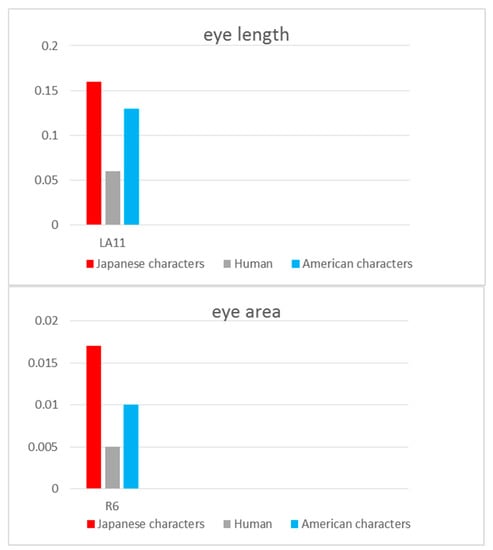
Figure 5.
Comparisons of eye area and length between the human face and American and Japanese cartoon characters.
Based on the data above, we inferred that both American and Japanese cartoon characters have a lengthened distance between the upper and lower eyelids. They also increase the eye area. Therefore, the eye is the focus of exaggeration. Thus, the impression of big eyes created by Japanese animation characters is real and universal. Although American cartoon characters also show the phenomenon of exaggerated eyes, they are much smaller than those of Japanese cartoon characters.
5.2. Nose
Figure 6 compared with the human face, the average values of LA2, LB3, R1, and A1 show that Japanese cartoon characters are 1.1 times longer in the nose, 1.6 times smaller in the width of the nose, 1.5 times smaller in the area of the nose, and 1.1 times larger in the angle between the nasal floor to the left nasal alar and to the eyebrows’ center.
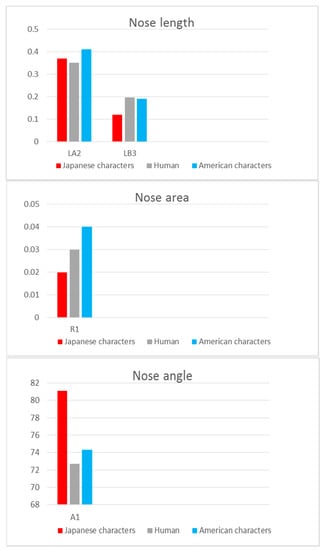
Figure 6.
Comparisons of area, angle, and length of the nose between the human face and American and Japanese cartoon characters.
Compared with the human face, the average values of LA2 and R1 show that American cartoon characters are 1.2 times longer in the nose and 1.3 times larger in the nose area.
The data indicate that the noses of Japanese cartoon characters are narrow and long, whereas American cartoon characters have longer and larger noses.
5.3. Ears
The data for LB6 as shown in Figure 7 show that the average ear width of Japanese cartoon characters is 1.9 times larger than those of the human face, whereas the average ear width of the American cartoon characters is 1.4 times larger than the human face. Therefore, the ears are also the focus of cartoon character designers, both American and Japanese cartoon characters have exaggerated ears.
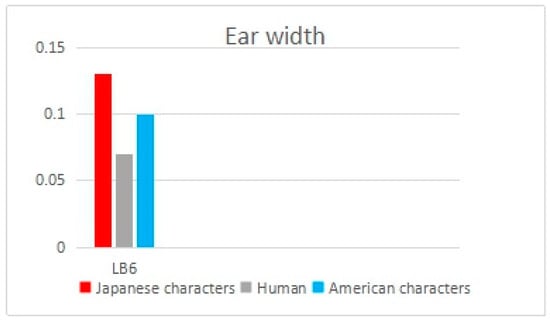
Figure 7.
Comparisons of the length of the ear between the human face and American and Japanese cartoon characters.
5.4. Mouth Position
Figure 8 compared with the human face, the average values of LA3 and LA4 show that Japanese cartoon characters have a 1.2 times longer nasal floor to lip line and a 1.6 times shorter length from the lip line to the chin. American cartoon characters are not significantly different from the human face in the above two lengths. The data above show that Japanese cartoon characters are 1.2–1.6 times lower in the mouth position than the human face on average. Therefore, the position of the mouth is an important part of the character design of Japanese cartoon characters. However, the mouth position does not vary significantly compared to the human face for American cartoon characters.
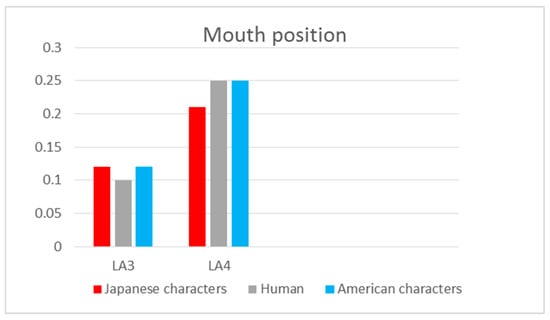
Figure 8.
Comparisons of the length of the mouth between the human face and American and Japanese cartoon characters.
5.5. Size of Different Areas of the Face
Besides facial features, the size of different areas of the face is an important aspect of cartoon character design. Five important components of facial shape were selected for analysis in this study: The size of the face, the size of the forehead, the size of the chin, the sharpness of the chin, and the width between the left and right mandible angle.
Figure 9 compared with the human face, the average value of R4 shows that Japanese cartoon characters have 1.25 times larger areas between the point of the left upper skull, the point of the left cheekbone, the lip tip point, and the point of the right upper skull.
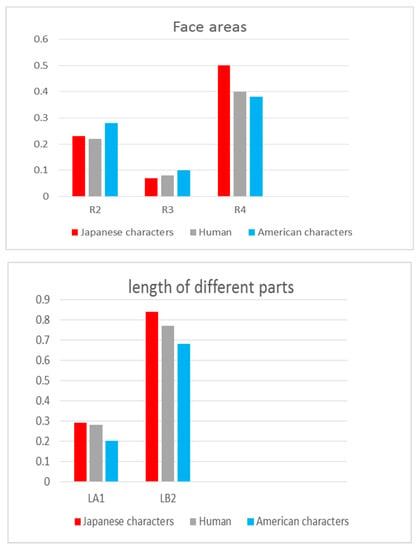
Figure 9.
Comparisons of the area of the face between the human face, and American and Japanese cartoon characters.
Compared with the human face, the average values of R2, R3, LA1, and LB1 show that American cartoon characters have 1.27 times larger areas between the middle point of the hairline, the point of the left and right mandible angles, and the base of the chin; 1.25 times larger areas between the left and right mandibular corner and the base of the chin, 1.4 times smaller foreheads, and 1.1 times larger skull widths.
We can learn from the data that Japanese animated characters exaggerate the facial area above the eyes. American cartoon characters have exaggerated areas in the middle face below the hairline and the area below the nose, but have smaller foreheads.
5.6. Size of Jaw
The average values of R3, LB5, and LB4 shown in Figure 10 demonstrated that there was no significant difference between Japanese cartoon characters and the human face for these aspects. However, the average value of R3, LB5, and LB4 shows that American cartoon characters have 1.25 times larger area between the left and right mandible angles and the chin, 1.1 times wider mandible angle, and 1.4 times longer distance from the nasal floor to the lip line.
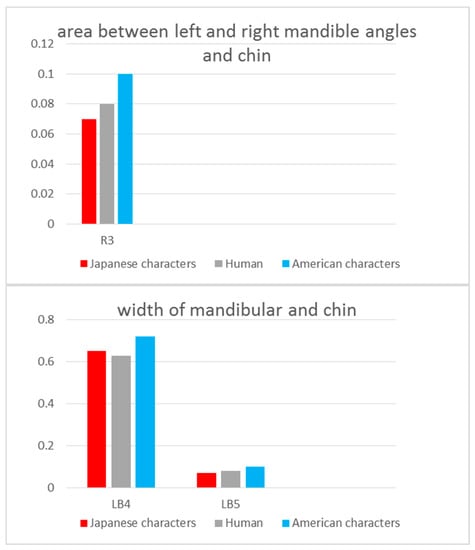
Figure 10.
Comparisons of the area and length of the jaw between the human face and American and Japanese cartoon characters.
As we showed above, Japanese cartoon character faces are smaller than the human face but there was no significant difference from the human face.
Data of the area, the length, and the width of the jaw prove that American cartoon characters have larger jaws, whereas Japanese animated characters have smaller jaws, but they are not significantly different from the jaws of the human face.
5.7. Sharpness of the Chin
The average values of A5 and A6 shown in Figure 11 demonstrated that there was no significant difference between Japanese cartoon characters and the human face. American cartoon characters are 8° larger in the sharpness angle of the chin than the human face, which is a significant difference, and 4.6° smaller in the angle between the chin and the common point at the lower right corner of the picture.
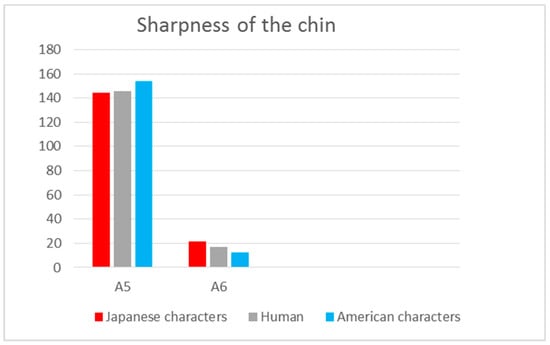
Figure 11.
Comparisons of the sharpness of the chin between the human face and American and Japanese cartoon characters.
The data above together show that the chins of Japanese cartoon characters are sharper than the human face but notably so, whereas the chins of American cartoon characters are rounder than human faces and Japanese cartoon characters.
5.8. Width between Left and Right Mandible Angle
The average values of A7 and A8 shown in Figure 12 demonstrated that Japanese cartoon characters exaggerated the angle from the left mandible angle to the chin and to the lower right corner of the picture by 4.6° and reduced the angle from the right mandible angle to the chin and to the lower right corner of the picture by 5°. There was no significant difference between American cartoon characters and the human face. Therefore, Japanese cartoon characters have wider mandibles than human faces and American cartoon characters.
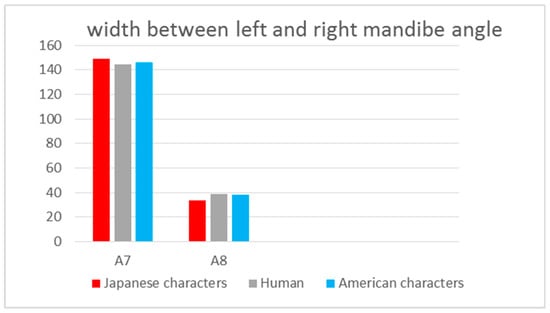
Figure 12.
Comparisons of the width of the mandible angle between the human face and American and Japanese cartoon characters.
6. Conclusions
By measuring and comparing the facial features of 100 American and Japanese cartoon characters with human facial features, we found that selecting a length value of a feature from a cartoon character which has the smallest standard deviation of all characters, as a common parameter is effective for the calculation of facial features of different cartoon characters.
Compared with the human face, seven main features were exaggerated. Designers always focused on the exaggeration or reduction of eyes, nose, ears, and chin, and considered the position of the ears and mouth. Compared with a human face, these features were exaggerated or reduced by different degrees. In addition, “nose” is the most obvious feature to distinguish the differences between American and Japanese animation characters.
Moreover, the facial features of animated characters were lengthened or shortened in the upper and lower distances and the left and right distances, without breaking the principle of symmetry.
This research provides a reference for the application and research of cartoon character facial design. However, the number of research samples is a limiting factor in this study. In future work, more samples should be collected for data analysis. In addition, new methods should be developed to measure occluded features. The research methods in this paper can be used to analyze the body proportion of cartoon characters.
Author Contributions
K.L. collected and analyzed data and wrote the manuscript. K.-M.C. designed the work and proposed and implemented the methods. J.-H.C. provided methodology suggestions and revised the manuscript.
Funding
This research received no external funding.
Acknowledgments
The authors are extremely grateful for the symmetry journal editorial team’s valuable comments on improving the quality of this article. Thanks to Zi-Ya Chen for designing the calculation program; Yu-na, Wu qun yi translated the paper, MDPI edited the language and thanks to the editors and the anonymous reviewers.
Conflicts of Interest
The authors declare no conflict of interest.
Appendix A

Table A1.
The animated movies where the animated characters are located and the links to the website.
Table A1.
The animated movies where the animated characters are located and the links to the website.
References
- Hayes-Roth, B.; Doyle, P. Animate characters. Auton. Agents Multi-Agent Syst. 1998, 1, 195–230. [Google Scholar] [CrossRef]
- Perkins, D. A definition of caricature and caricature and recognition. Stud. Vis. Commun. 1975, 2, 1–24. [Google Scholar] [CrossRef]
- Johnston, O.; Thomas, F. The Disney Villain; Disney Editions: New York, NY, USA, 1993. [Google Scholar]
- Lasseter, J. Principles of traditional animation applied to 3D computer animation. ACM Siggraph Comput. Gr. ACM 1987, 21, 35–44. [Google Scholar] [CrossRef]
- Redman, L. How to Draw Caricatures; McGraw Hill Professional: New York, NY, USA, 1984. [Google Scholar]
- Hughes, A. Learn to Draw Caricatures; HarperCollins: London, UK, 1999. [Google Scholar]
- Lu, A.S. What race do they represent and does mine have anything to do with it? Perceived racial categories of anime characters. Animation 2009, 4, 169–190. [Google Scholar] [CrossRef]
- Byatt, G.; Rhodes, G. Recognition of own-race and other-race caricatures: Implications for models of face recognition. Vis. Res. 1998, 38, 2455–2468. [Google Scholar] [CrossRef]
- Goldman, M.; Hagen, M. The forms of caricature: Physiognomy and political bias. Stud. Vis. Commun. 1978, 5, 30–36. [Google Scholar] [CrossRef]
- Weise, T.; Li, H.; Van Gool, L.; Pauly, M. Face/off: Live facial puppetry. In Proceedings of the 2009 ACM SIGGRAPH/Euro Graphics Symposium on Computer Animation, New Orleans, LA, USA, 1–2 August 2009. [Google Scholar]
- Chen, W.; Shi, M.; Qingjie, S. Caricature Synthesis and Exaggeration Based on Facial Features and their Relationship. J. Comput. Aided Des. Comput. Gr. 2010, 22, 121–128. [Google Scholar] [CrossRef]
- Mike, M. The Face of Tomorrow Project. 2010. Available online: https://www.digitalphotopix.com/people/the-face-of-tomorrow/ (accessed on 12 May 2018).
- Grammer, K.; Thornhill, R. Human (Homo sapiens) facial attractiveness and sexual selection: The role of symmetry and averageness. J. Comp. Psychol. 1994, 108, 233. [Google Scholar] [CrossRef] [PubMed]
- Tversky, B.; Baratz, D. Memory for faces: Are caricatures better than photographs? Mem. Cognit. 1985, 13, 45–49. [Google Scholar] [CrossRef]
- Alley, T.R.; Cunningham, M.R. Article Commentary: Averaged Faces Are Attractive, but Very Attractive Faces Are Not Average. Psychol. Sci. 1991, 2, 123–125. [Google Scholar] [CrossRef]
- Rhodes, G.; Tremewan, T. Averageness, exaggeration, and facial attractiveness. Psychol. Sci. 1996, 7, 105–110. [Google Scholar] [CrossRef]
- Kris, E.; Gombrich, E. The Principles of Caricature 1. Br. J. Med. Psychol. 1938, 17, 319–342. [Google Scholar] [CrossRef]
- Hyde, J.; Carter, E.J.; Kiesler, S.; Hodgins, J.K. Perceptual effects of damped and exaggerated facial motion in animated characters. In Proceedings of the 2013 10th IEEE International Conference and Workshops on Automatic Face and Gesture Recognition (FG), Shanghai, China, 22–26 April 2013; IEEE: Piscataway, NJ, USA; pp. 1–6. [Google Scholar]
- Blair, P. Animation: Learn How to Draw Animated Cartoons; Walter T. Foster, 1949; Available online: https://https://www.doc88.com/p-717876831672.html (accessed on 12 May 2018).
- Ames, W.; Kunzle, D.M. Caricature, Cartoon, and Comic Strip. Encycl. Br. 1978, 909–922. Available online: https://www.britannica.com/art/caricature-and-cartoon (accessed on 12 May 2018).
- Belletti, N.E.; Wade, T.J. Racial characteristics and female facial attractiveness perception among United States university students. In Racism in the 21st Century; Springer: Berlin, Germany, 2008; pp. 93–124. [Google Scholar]
- Meagher, K.; Neal, M. The Influence of Disney: The Effects of Animated Facial Features on Children’s Perceptions’. Available online: http://psych.Hanover.Edu/research/Thesis05/MeagherNeal.pdf (accessed on 5 October 2005).
- Toku, M. Cross-cultural analysis of artistic development: Drawing by Japanese and US children. Vis. Arts Res. 2001, 27, 46–59. [Google Scholar]
- McCloud, S. Understanding Comics: The Invisible Art; William Morrow Paperbacks: Northampton, MA, USA, 1993. [Google Scholar]
- Cohn, N. A different kind of cultural frame: An analysis of panels in American comics and Japanese manga. Image Narrat. 2011, 12, 120–134. [Google Scholar]
- Turk, M.; Pentland, A. Eigen faces for recognition. J. Cognit. Neurosci. 1991, 3, 71–86. [Google Scholar] [CrossRef]
- Pentland, A.; Moghaddam, B.; Starner, T. View-based and modular eigen spaces for face recognition. In Proceedings of the 1994 IEEE Conference on Computer Vision and Pattern Recognition, Seattle, WA, USA, 21–23 June 1994. [Google Scholar]
- Yun-Hong, W.; Fan, W.; Tan, T.-N. Face Recognition Based on Information Fusion. Chin. J. Comput. 2005, 28, 1657. [Google Scholar]
- Yue-Long, L.I.; Jin, Y.; Wang, J.M.; Xiao, Z.T.; Geng, L. Face Feature Points Extraction: A Review. Chin. J. Comput. 2016. [Google Scholar] [CrossRef]
- Altes, K.B. Feature proportion accuracy of hand-drawn facial approximation. Sci. Justice 2016, 56, 443–452. [Google Scholar] [CrossRef]
- Meethongjan, K. Wavelet and Moment Invariants Based Features Selection Using Voronoi Diagram for Face Recognition. Ph.D. Thesis, Universiti Teknologi Malaysia, Skudai, Malaysia, 2013. [Google Scholar]
- Cootes, T.F.; Taylor, C.J. Statistical Models of Appearance for Computer Vision; Technical Report; University of Manchester: Manchester, UK, 2004. [Google Scholar]
- Milborrow, S.; Nicolls, F. Locating facial features with an extended active shape model. In European Conference on Computer Vision; Springer: Berlin/Heidelberg, Germany, 2008; pp. 504–513. [Google Scholar]
- Viola, P.; Jones, M.J. Robust real-time face detection. Int. J. Comput. Vis. 2004, 57, 137–154. [Google Scholar] [CrossRef]
- Cabeza, R.; Kato, T. Features are also important: Contributions of featural and configural processing to face recognition. Psychol. Sci. 2000, 11, 429–433. [Google Scholar] [CrossRef]
- Brennan, S.E. Caricature generator: The dynamic exaggeration of faces by computer. Leonardo 1985, 18, 170–178. [Google Scholar] [CrossRef]
- Talekar, A.S. Facial Caricatures on Mobile Devices. Available online: http://xueshu.baidu.com/usercenter/paper/show?paperid=347aa49472352787233babcac4c28369&site=xueshu_se (accessed on 12 May 2018).
- Liang, L.; Chen, H.; Xu, Y.-Q.; Shum, H.-Y. Example-based caricature generation with exaggeration. In Proceedings of the 10th Pacific Conference on Computer Graphics and Applications, Beijing, China, 9–11 Octobor 2002; IEEE: Piscataway, NJ, USA, 2002; pp. 386–393. [Google Scholar]
- Mra, M.Z.; Colton, S.; McCann, J. Coucou: Cartoon Face Producer. 2004. Available online: https://citeseerx.ist.psu.edu/viewdoc/download?doi=10.1.1.103.6687&rep=rep1&type=pdf (accessed on 12 May 2018).
- Li, H.; Weise, T.; Pauly, M. Example-based facial rigging. ACM Trans. Gr. (TOG) 2010, 29, 32. [Google Scholar]
- Weise, T.; Bouaziz, S.; Li, H.; Pauly, M. Real time performance-based facial animation. ACM Trans. Gr. (TOG) 2011, 30, 77. [Google Scholar]
- Li, H.; Yu, J.; Ye, Y.; Bregler, C. Real time facial animation with on-the-fly correctives. ACM Trans. Gr. 2013, 32, 1–42. [Google Scholar]
- Ouzounis, C.; Kilias, A.; Mousas, C. Kernel projection of latent structures regression for facial animation retargeting. arXiv 2017, arXiv:1707.09629. [Google Scholar]
- Mousas, C.; Anagnostopoulos, C.-N. Structure-aware transfer of facial blend shapes. In Proceedings of the 31st Spring Conference on Computer Graphics, Smolenice, Slovakia, 22–24 April 2015; ACM: New York, NY, USA, 2015; pp. 55–62. [Google Scholar]
- Ma, L.; Deng, Z. Real-Time Facial Expression Transformation for Monocular RGB Video. Comput. Gr. Forum Wiley Online Libr. 2019, 38, 470–481. [Google Scholar] [CrossRef]
- Wei, L.; Deng, Z. A practical model for live speech-driven lip-sync. IEEE Comput. Gr. Appl. 2015, 35, 70–78. [Google Scholar] [CrossRef] [PubMed]
- Available online: https://www.rottentomatoes.com (accessed on 5 November 2016).
© 2019 by the authors. Licensee MDPI, Basel, Switzerland. This article is an open access article distributed under the terms and conditions of the Creative Commons Attribution (CC BY) license (http://creativecommons.org/licenses/by/4.0/).
